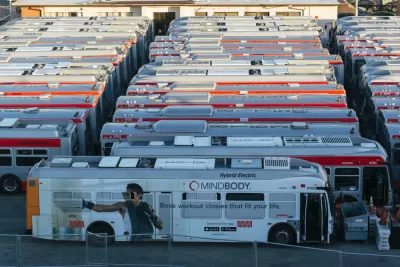Across U.S. cities, transit agency boards are overwhelmingly more suburban than their riders, causing a disconnect between decisionmakers and the people who regularly use transit.

As a new participant to their meetings, Cam Hardy, president of the Better Bus Coalition, noticed something about the board of the Southwest Ohio Regional Transit Authority, writes Jake Blumgart. They were, in Hardy’s words, “Very white, very corporate and very resistant to change. Just cutting this and that [transit service] without really analyzing why a route might not be working.” Most of them, Hardy said, did not use transit themselves.
“This is not an unusual dynamic, a new study from TransitCenter shows. The advocacy and research group studied transit agencies across 11 cities — Cincinnati not among them — and found that their boards were not representative in terms of gender, race or geography.” According to the study, “In New York, 88 percent of riders live in the city but only 18 percent of board seats go to their representatives.” On average in the study cities, 75 percent of riders lived in central cities, with 40 percent of board appointments going to those jurisdictions. Meanwhile, many boards hold meetings at times inconvenient to working people, making it more difficult for transit riders to participate.
Like other advocates around the country, Hardy’s organization fought for years to make changes to the SORTA board. “They got half of the meetings changed to evening hours, so work-a-day residents can attend. There are now regular bus riders on the board, who can speak to their lived experiences on the system.”
As Blumgart notes, “In an era of partisan polarization around transportation policy, it can be important to have boardmembers who can speak on transit’s behalf in spaces like state legislatures that tend to be dominated by conservative, white and non-urban political forces.”
FULL STORY: There’s a Big Difference Between Transit Boards and Riders

Alabama: Trump Terminates Settlements for Black Communities Harmed By Raw Sewage
Trump deemed the landmark civil rights agreement “illegal DEI and environmental justice policy.”

Planetizen Federal Action Tracker
A weekly monitor of how Trump’s orders and actions are impacting planners and planning in America.

The 120 Year Old Tiny Home Villages That Sheltered San Francisco’s Earthquake Refugees
More than a century ago, San Francisco mobilized to house thousands of residents displaced by the 1906 earthquake. Could their strategy offer a model for the present?

In Both Crashes and Crime, Public Transportation is Far Safer than Driving
Contrary to popular assumptions, public transportation has far lower crash and crime rates than automobile travel. For safer communities, improve and encourage transit travel.

Report: Zoning Reforms Should Complement Nashville’s Ambitious Transit Plan
Without reform, restrictive zoning codes will limit the impact of the city’s planned transit expansion and could exclude some of the residents who depend on transit the most.

Judge Orders Release of Frozen IRA, IIJA Funding
The decision is a victory for environmental groups who charged that freezing funds for critical infrastructure and disaster response programs caused “real and irreparable harm” to communities.
Urban Design for Planners 1: Software Tools
This six-course series explores essential urban design concepts using open source software and equips planners with the tools they need to participate fully in the urban design process.
Planning for Universal Design
Learn the tools for implementing Universal Design in planning regulations.
Clanton & Associates, Inc.
Jessamine County Fiscal Court
Institute for Housing and Urban Development Studies (IHS)
City of Grandview
Harvard GSD Executive Education
Toledo-Lucas County Plan Commissions
Salt Lake City
NYU Wagner Graduate School of Public Service





























